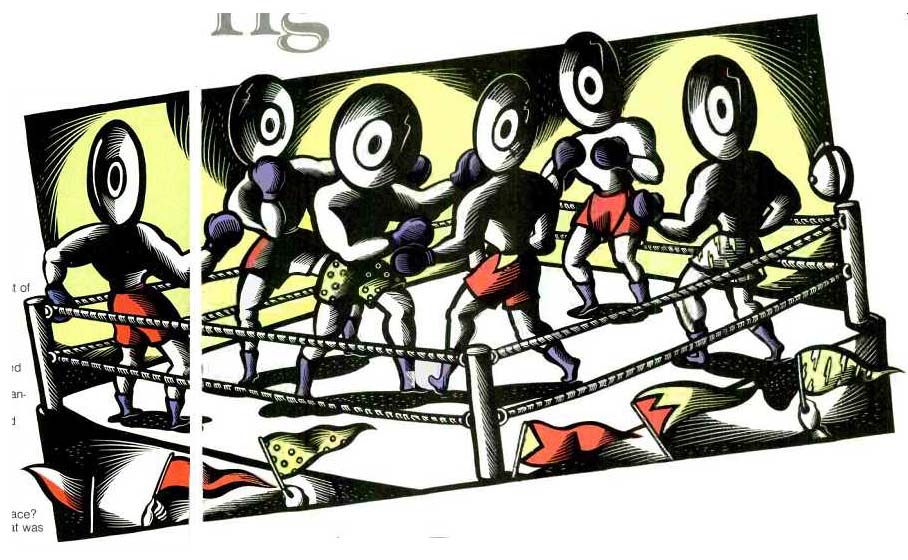
By JOE WIESENFELDER
Roughly two years have passed since the Ban the Box Coalition formed to rid the music industry of the wasteful cardboard longbox in which Compact Discs are pack aged. In 1991, ban-the-box legislation was introduced in California and New York, and a consensus has formed that the longbox's days are numbered; it's practically a dead issue.
Given that, a new controversy has arisen over what type of package will take the place of the longbox/jewel box combination. What has resulted is a prize fight of sorts. But it's unlike any you've seen. This match isn't limited to two boxers. In fact, anyone can get into the ring. And if that's not confusing enough, the rules keep changing--because there's more than one referee. As with all title fights, millions of dollars are at stake, which has the contenders questioning each other's qualifications, all the while claiming to be the true people's choice.
The people may have assumed that the standard clear-plastic jewel box would re main, sans longbox, as in the rest of the world. That’s still a possibility, but there's a hitch. The longbox was introduced so that American retailers could split LP bins in order to display two rows of CDs affordably. If ban-the-box environmentalists were the first referee, then retailers, represented by the National Association of Recording Merchandisers (NARM), were the second. Their rule? Any new package must meet the approximate dimensions of the longbox (6 x 12 inches), to maintain theft prevention and merchandising and to avoid the cost of re-fixturing retail outlets. In keeping with the ban-the-box movement, NARM's guidelines also requested that manufacturers produce environmentally "friendly" alternatives.
Jewel box-only advocates objected to being thrown out of the ring and formed Jewel-box Advocates and Manufacturers (JAM), a coalition of Dow Plastics, other plastics interests, and consumers wanting to save the plastic case. Susanna Seirafi, marketing coordinator for Lift Display Systems and spokes person for JAM, asks, "Why do we have to replace something that shouldn't have existed in the first place? Why are the retailers using a bin that was designed for an LP?" JAM and the original Ban the Box Coalition proposed that some of the savings resulting from the elimination of the longbox go to retailers to help absorb re-fixturing costs, an idea not embraced by NARM or the record labels. Miriam Granberg, director of public affairs and government relations for NARM, says, "The actual bookkeeping, the accounting in determining who got what, would have been so ridiculous that, administratively, to do that would have cost 10 times more than they would have saved.
"You still would not be meeting the two major concerns of the retailer," Granberg adds, "neither of which is the cost of re-fixturing-eventually all retail stores redo their fixtures. Sure it would be expensive, but that's not the point. The point is that they would lose the security, and they would lose the ability to merchandise the way they had."

above: The jewel box is used both in the long JAM-Pak and in closed shrink
wrapped form.
The Contenders
Before the start of the bout, the jewel box was a favorite, partly because it's had a long career, its production means are already established, and it has the most (or at least the most vocal) supporters. Some music industry sources claim that early in 1991, the big six record distributors had acquiesced and were to decide a timetable for switching to the shrink-wrapped jewel-box format at a NARM convention last March. The introduction of Warner Music Group's Eco-Pak at this meeting is said to have stalled them. Slated for use with all WEA (Warner/Elektra/Atlantic) releases early in 1992, the Eco-Pak is a four-panel paperboard and plastic package (the manufacturer calls it eight-panel, counting surfaces rather than segments). Shrink wrapped with only two of its three paper board hinges folded, the longbox-sized package is made rigid by the plastic CD tray that spans the open hinge. After purchase, the consumer removes the wrap, slides the tray into its permanent position, and closes the package down to near jewel box dimensions with an audible click. When the WEA distribution group, which controls 40% of the domestic market, turned away from the jewel box, the other groups decided to reassess, allowing other contenders to enter the ring.
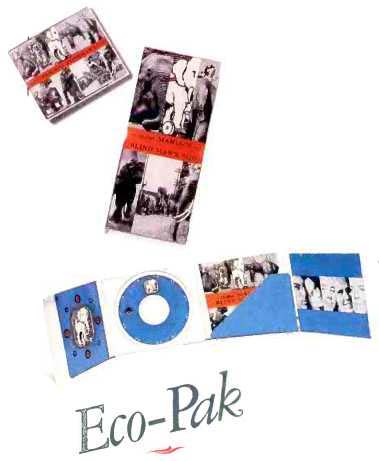
The Eco-Pak has not yet made its debut, but it is often confused with a contender
from the same neighborhood, the DigiTrak, a similar four-panel paperboard package
with less plastic and a wraparound rather than latched closure. DigiTrak was
the first alternative on the scene, introduced to consumers on the grand scale
with Sting's A&M release The Soul Cages in January '91, followed in June
by Bonnie Raitt's Luck of the Draw on Capitol. Unlike the Eco-Pak, the DigiTrak
has a fixed tray and uses plastic rails, or tracks, to stiffen the length of
the shrink-wrapped package. After purchase, these would presumably be thrown
away, an environmental no-no. (The DigiTrak, manufactured by Al bum Graphics
Incorporated, or AGI, is a variation of the company's DigiPak, a two-or three-panel
paperboard package introduced by Island Records in the mid-'80s with Robert
Palmer's Riptide, among others, and now frequently used for CD maxi-singles.)
Brooklyn designer David Cowan introduced one of several all-plastic alternatives
into the ring. "Weighing in" at the same dimensions
as the jewel box, the Inch Pack utilizes a slide-out CD drawer rather than
a hinged cover. This allows the boxes to be opened even when stacked. (The
original name, Stack Pack, has been abandoned.) The boxes lock together like
Lego blocks, which prevents them from falling over if stacked or grouped side
by side on a shelf.
For retail, the package is simply shrink wrapped with the tray slid out, and only the wrap is thrown away.
Produced by Reynard C V C, the Laserfile is another plastic alter native that utilizes a drawer-type CD tray and is shrink-wrapped in the open position. The packages are also stackable, though they don't lock together, and are distinguished by the drawer tray, part of which hinges downward, facilitating CD removal and insertion into in-dash car CD players. Reynard C V C's executive director, Arthur Herr, says the package uses less plastic overall than the standard jewel box, and the CD tray is made from 100% recycled poly propylene. (Almost the full amount is from post-consumer waste, which would other wise go to landfill; pre-consumer waste is factory trimmings, etc., now regularly recovered and reused.) Here too, only the wrap is discarded.
In this corner, wearing the green shorts, is the C-Case. "We're selling ourselves as a green alternative," says C-Case president Bill Dobias. "We don't think there are many others out there that have paid a lot of attention to it yet." The C-Case is a three-panel, all-paperboard package with a pocket apiece for the booklet and disc. Dobias says the case consists of 100% recycled paper board, including 40% to 45% post-consumer material. According to C-Case literature, the all-paperboard construction makes the package easily recyclable, unlike paper board/plastic combinations. C-Case takes it a few steps further, implementing a dioxin-free bleaching process and using only agri oil inks and aqueous or soybean coatings, which are biodegradable and low in toxicity.
In addition to the shrink-wrap, C-Case uses a paperboard strip, or "belly band," to stiffen the open package for retail. Though it might be seen as disposable, C-Case has developed uses for the band, such as business-reply cards and spine labels for people who choose to transfer the CD to a jewel box.
The wraps can also display the title for retail purposes, allowing designers to orient the cover art horizontally.
JAM has introduced the JAM-Pak, an open jewel box shrink-wrapped with a strong Mylar (versions using standard wrap broke too easily). Seirafi says the wrap comes from 100% recycled material and is recyclable.
She stresses that the JAM-Pak is a transition package to eliminate the longbox immediately; JAM's goal is still a closed, shrink wrapped jewel box. "The retailers have so much power, it's unbelievable," she says.
"As long as it's 6 x 12-if it's made out of chocolate-they don't even care. Just as long as they don't have to re-fixture." Sony Music developed a package (not shown) following commissioned tests in which consumers preferred an open jewel box-type package (Sony used the Inch Pack) over the standard jewel box (both alone and with the longbox). The open package is stiffened by its tray, which must be removed and reoriented by the consumer after purchase.
A 5 x 11-inch "collectible poster" serves as a cover for retail purposes-arguably a disposable element. "We're pretty muchcom mitted to go with a plastic case," says Sony Music Distribution president Paul Smith. "We believe the consumer is very much in favor of that."

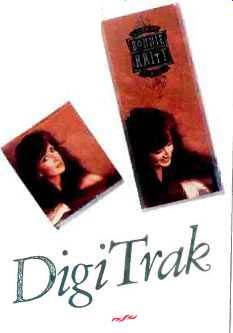
The DigiTrak's plastic strips, called "tracks," are thrown
out after purchase.
The Odds
Comparisons are difficult. Manufacturers won't specify costs, but most claim their packages cost less to make than the current longbox/jewel box combo. Music buyers have only had their hands on the DigiTrak and shrink-wrapped jewel box. (Last year Geffen Records released Peter Gabriel's Shaking the Tree only in shrink-wrapped jewel box-causing some retailers to keep it behind the counter, out of sight; others re fused to carry the disc initially.) For the first time, comparisons can be made when sales figures come in for U2's Achtung, Baby, which Island Records released last November in both DigiTrak and shrink-wrapped jewel box (though retailer preference will be gauged more easily than consumer).
In a CD Review reader poll last April, 87% of the 4,500-plus respondents preferred the jewel box to paperboard, but AGI sources say the test was unscientific and invalid because it showed a generic brown paper board package, eliminating the graphics that are the material's major appeal.
Capitol Records reports receiving a few hundred consumer letters about the Raitt DigiTrak, from nearly one million units sold, most expressing dissatisfaction with the package and many supporting the jewel box. Lou Mann, Capitol's senior vice president of sales, says, "I don't know if that's a good ratio, a bad ratio. I have nothing to gauge this by." A&M reports roughly 100 letters of the same type about the Sting package, from sales exceeding 4 1/2 million worldwide (the DigiTrak was only used domestically, however).
Letters aside, ask around and you'll find the DigiTrak was not well received. Consumers complained that the package didn't close squarely and that the paperboard surfaces and hinges would wear and tear.
Jim Oppenheimer, AGI's vice president of sales and marketing, says the company is working on a three-panel version of the DigiTrak in response to criticism of the original, four-panel version. The latter will still be available for labels wanting more graphics real estate but will be reconfigured, Oppenheimer says, so it will be easier to fold, following criticism for committing to the Eco-Pak without conducting consumer testing, Warner Music Group commissioned Chilton Re search to do so. However, they tested the renamed Eco-Pak Jewel Box versus the longbox/jewel box-not versus the shrink wrapped jewel box or alternative packages.
The results were predictable: Participants preferred the Eco-Pak four to one. Opponents criticized Warner for muddying the waters with the name change, called the study moot, and publicly questioned Warner's motives, noting that the Eco-Pak is designed and manufactured by the Ivy Hill Corporation, a wholly owned subsidiary of Time Warner, parent company of WEA.
By then, the paperboard package interests had formed their own booster group, the Entertainment Packaging Council, comprised of the companies that designed the Eco-Pak and DigiTrak as well as other paper board and package manufacturers licensed to manufacture them. Like JAM, EPC has a lot of money riding on its contenders, and the members of either entourage stand to win a large purse from the success of their respective packages. Longtime jewel box advocate Robert Simonds, chief financial officer of Rykodisc and founder of the Ban the Box Coalition, says, "The people with the most to lose with getting rid of the longbox are the pack aging companies. All these packaging companies don't make any money on jewel boxes. They don't sell plastic. They sell card board. So they all have a specific interest in seeing a cardboard package become the new standard. And it gets even worse be cause you have a company like Ivy Hill, which is owned by Warner Communications.
So in effect you have Warner Bros. Records, the biggest record company in the world, with an expressed financial interest in seeing this package that they are backing, the Eco Pak, become the new standard." A review of EPC and JAM claims and counterclaims shows valid points on both sides, amid a good deal of misinformation.
EPC ran drop tests on the jewel box and reported that they break if dropped from a height of 3 feet onto almost any surface, even carpet. Consumers agree that jewel boxes do break, especially the hinges, particularly if the case is open when dropped.
JAM's Seirafi says, "That is one valid point that the hinges break, but another valid point is that you can replace it. You can't replace an Eco-Pak if you spill on it, if it rips." Ivy Hill's executive vice president, Arthur Kern, says the Eco-Pak is plenty durable.
"It's totally surrounded on all sides by plastic rails that protect the board from dog-earing, so the complaint by the JAM people that paperboard is not as durable, I think, is a fallacious argument." Another shortcoming of the jewel box is limited graphics capability. In an article on CD packaging in the May/June issue of Print magazine, a number of music-business de signers lamented the design limitations of the present jewel box. Paperboard proponents say their material is more versatile, allowing embossing, die cutting, and more printable surfaces. Kern says, "We've developed a package that gives to the consumer the same kind of graphics attraction at retail and also gives the consumer much more graphics attraction in a package that he takes home and keeps." n the other hand, it appears that extra panels make the paperboard packages more cumbersome to open and close, often causing con fusion-a major consumer complaint about the DigiTrak. At a Congressional hearing on product packaging last year, Representative Al Swift of Washington, chairman of the House Subcommittee on Transportation & Hazardous Materials, called Warner's Eco Pak a Rube Goldberg contraption. "You have the instructions here so somebody can figure out how to do this....
I don't care whether you do the jewel box and shrink-wrap it which seems to me the preeminently sensible thing to do-or do something else. As a public policy maker, I guess I don't care; I tell you, as a consumer, I hate that box."
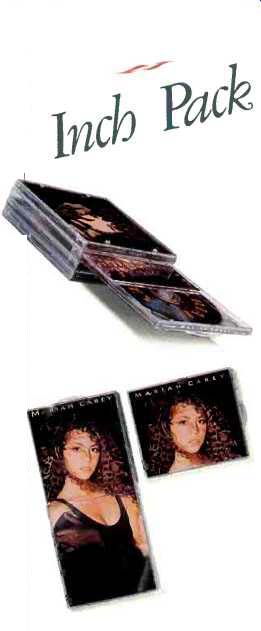
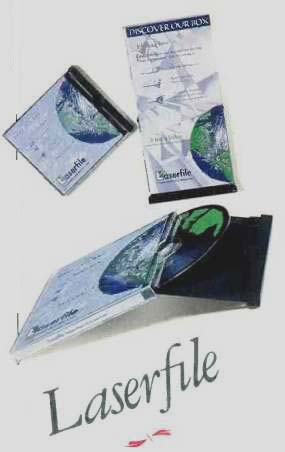
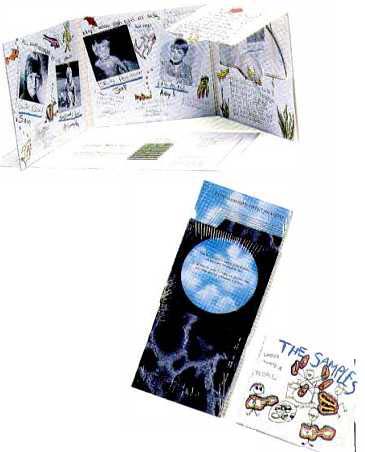
above: The C-Case's "belly band" stiffens-- the package in its
retail configuration and is printed as a business-reply card.
For more information, contact the following organizations:
JAM: Jewelbox Advocates and Manufacturers P.O. Box 1278 Old Chelsea Station New York, N.Y. 10011 (800) 882-4JAM EPC: Entertainment Packaging Council 30 Rockefeller Plaza 24th Floor New York, N.Y. 10021 (212) 353-3030
It's Not Easy To Be Green
Because little will be thrown away by consumers, all the alternative packages are considerably more environmentally sound than the disposable longbox, but debate rages over the recyclability of manufacturer re turns. (The amount of unsold merchandise varies per label and release but equals roughly 10%. Industry-wide, most returns were heretofore sent to landfills or shipped overseas for recycling.) Ivy Hill's intentions were clear in naming its package the Eco Pak, but when Kern approached the Earth Communications Office (ECO) last June for an endorsement, the Hollywood environmental communications organization refused, citing problems with the recycling of paper bonded to plastic and the absence of any guarantee to use recycled stock. Floyd Glinert, executive vice president of marketing for Shorewood Packaging Corporation and EPC's chairman, says, "That's an artist's preference. If the artist says, 'I want mine to be on recycled board,' so be it." at the time, ECO instead endorsed the shrink-wrapped jewel box, pending a review of other alternatives. Bruce Hartzell, ECO's project director, says the group is not completely satisfied with the jewel box because they believe it should have more recycled con tent. "We're going for the best package," he says. "The one that has the most recycled content, can be recycled itself, and uses the least amount of material." Since ECO's initial rejection of the Eco Pak, Ivy Hill's Kern has announced that the company is working on a machine that would separate the plastic and paperboard parts of the Eco-Pak, rendering both recyclable.
Gary Petersen, ECO's recycling advisor, says, "I'm from Missouri. Show me." Petersen, vice president of Waste Management of California/Recycle America and a 22-year veteran of recycling, adds, "Everything's recyclable. It's just a matter of cost." Environ mentalists are also skeptical, saying that the separation procedure, if possible, would likely be prohibitively costly.
Producers of plastic packages are in a similar situation. To make clear plastic from 100% recycled material would require a supply of clear polystyrene plastic in the recycling stream, which does not presently exist.
JAM has been trumpeting that the National Polystyrene Recycling Company (NPRC) is challenging record companies to set up such a stream. Resa Dimino, outreach coordinator for Environmental Action's Solid Waste Alternatives Project, is doubtful. "The NPRC was created by the eight largest manufacturers of polystyrene," she says. "It's only succeeding as far as it has because of heavy industry subsidy." ECO's Hartzell says, "There's a lot of questioning in the environmental movement about how effective the NPRC is and exactly what's happening with all the 'styrene." Environmentalists agree that it would be unwise to choose package type largely on the basis of recycling processes and streams that do not yet exist, leaving pack agers crying "Catch-22."
Petersen still favors a plastic alternative because, he says, "You have to look at the long-term durability of product design. When you look at the Eco-Pak, it's a fiber material and it folds. That fiber material will eventually tear or wear out. If you're looking for longevity in product usage, you're looking at plastic as lasting three, four, five times as long be cause there's no parts to wear out. . . . Be sides, you're still wasting more material. Why do that ? If in Japan and Canada and Europe they can use just the jewel box, what the hell's the matter with us ?" ECO's executive director, Bonnie Reiss, says the group has now viewed the Laserfile, JAM-Pak, and DigiTrak and may have found a new favorite in the Inch Pack. But rather than endorse a particular package, Reiss says ECO is working with the National Re sources Defense Council (NRDC) and Californians Against Waste to establish guide lines "that will become the industry standard." The guidelines should be complete by the time you read this.
"We hadn't seen an alternative package that wasn't extremely wasteful in using re sources," Reiss says. "That's why we always said we were going jewel box-only. But we can find common ground; no one wants to waste money and resources throwing out the existing racks in all the retail outlets across the United States if another alternative can be found that really uses less material in the packaging."
Even nonpartisan environmentalists are at odds about many of the concerns of the CD packaging battle, but all seem to agree on the importance of source reduction, reducing package size. Jonathan Kimmelman, a research associate with NRDC, says the group is currently crusading to decrease the ratio of package to product size. Kimmelman has not seen the Eco-Pak or DigiTrak but says the smaller C-Case, though true to its environmental claims, "is still fairly big pack aging." Environmental Action's Dimino says the C-Case's percentages of recycled con tent are "pretty good," but "there was a lot of material-if it could be done with less, that would be better." Bulk and longevity questions aside, environmentalists also pit plastic and paper against one another in considering the front end environmental impacts of production.
Recycler Petersen says, "The plastics recycling process produces far less environmental impact than the processing of aluminum, glass, or paper. It's a much more desirable package to be recycled." Dimino disagrees. "The production of polystyrene is a very hazardous process," she states. "On EPA's ranking of the 20 chemical processes that create the most hazardous waste, three of the top six processes are related to the manufacture of poly styrene.
"Everyone knows that the production of paper is problematic," she adds. "The difference as I see it is there is hope for cleaning up the paper production and paper recycling process. You cannot make polystyrene with out using these hazardous chemicals; the problems are inherent."
The Winner, by Decision...
As it stands, the Warner Music Group is still committed to its Eco-Pak, while Sony will continue testing before committing to any package, even their own. Three independent labels have adopted the C-Case. American Helix, the first CD replicator to endorse an alternative package, has already shipped more than 10,000 units in the C-Case. "It's the only environmentally correct package oil its kind." says Marc Feingold, American Helix's director of sales and marketing. "We feel strongly that the C-Case is the way to go." David Cowan says the six major record distributors are looking at the Inch Pack, and Arthur Herr says all but WEA are looking at the Laserfile. Susanna Seirafi says a major label will be implementing the JAM-Pak early this year. Capitol and A&M are now considering other packages for future use, but neither one is ruling out the DigiTrak.
Robert Simonds says Rykodisc has made no decision, though it would be easiest to go with a standard jewel box-type package.
"From our standpoint, and from most independent labels' standpoint, anything outside of a jewel box is going to be a nightmare for us to deal with," he says. "None of the alternative packages are cost effective in small runs. . . If the U.S. adopts anything other than a jewel box standard, then we will in effect be creating an entirely new format from a record company standpoint. Any company that does business in any other country can't expect to sell CDs outside of the U.S. unless they create a completely different package, the jewel box." To have one standard package now seems a pipe dream. Unless a knockout alternative emerges, it's clear the winner--or winners--will be chosen by decision. At Audio, we have so far received only one letter on this whole topic. Your efforts in this matter would best be directed toward the referees-in this case, the record companies.
Let's hope that once the industry's rules are met, we have a champ for which the fans are still willing to pay the ticket price.
(adapted from Audio magazine, Feb. 1992)
= = = =